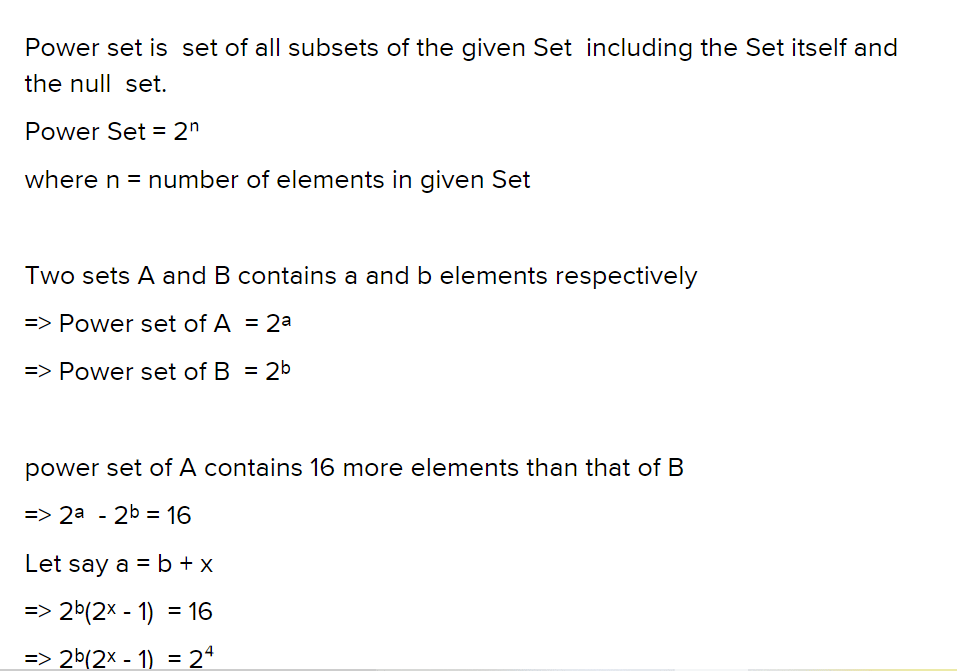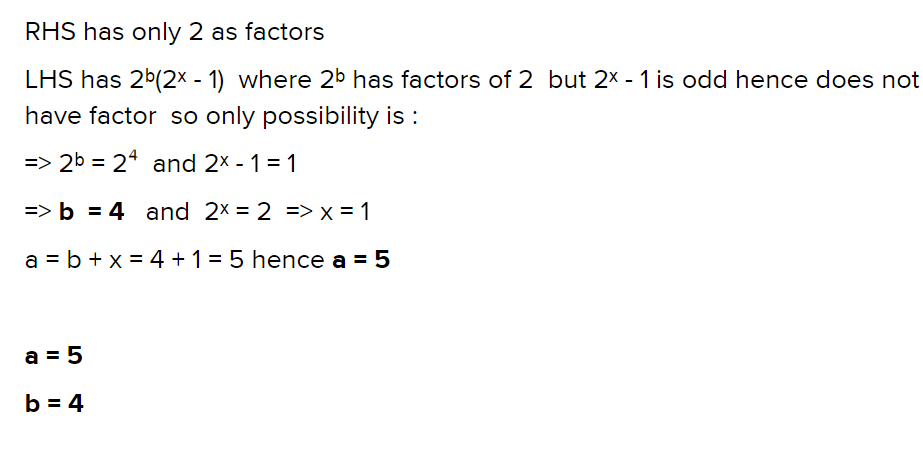CA Foundation Exam > CA Foundation Questions > Two sets a and b contains a and b elements re...
Start Learning for Free
Two sets a and b contains a and b elements respectively.If power set of A contains 16 more elements than that of B,value of 'b' and 'a' are respectively?
Verified Answer
Two sets a and b contains a and b elements respectively.If power set o...
Solution :




 This question is part of UPSC exam. View all CA Foundation courses
This question is part of UPSC exam. View all CA Foundation courses
Most Upvoted Answer
Two sets a and b contains a and b elements respectively.If power set o...
Given Information:
- Set A contains 'a' elements.
- Set B contains 'b' elements.
Objective:
To find the values of 'a' and 'b' such that the power set of A contains 16 more elements than the power set of B.
Solution:
Let's break down the problem into smaller steps.
Step 1: Understanding the Power Set
The power set of a set is the set of all possible subsets of that set, including the empty set and the set itself. For example, the power set of {1, 2} is {{}, {1}, {2}, {1, 2}}.
Step 2: Calculating the Size of Power Sets
The size of the power set is given by 2^n, where n is the number of elements in the original set. This formula holds true because for each element in the original set, there are two possibilities: either it is included in a subset or it is not.
Step 3: Formulating the Equation
Let's denote the number of elements in set A as 'a' and the number of elements in set B as 'b'. Therefore, the sizes of their power sets will be 2^a and 2^b, respectively.
According to the given information, the power set of A contains 16 more elements than the power set of B. Mathematically, we can represent this as:
2^a = 2^b + 16
Step 4: Solving the Equation
To find the values of 'a' and 'b', we need to solve the equation we formulated in the previous step.
Taking the logarithm (base 2) of both sides of the equation, we get:
log2(2^a) = log2(2^b + 16)
Using the logarithmic property log2(x^y) = y * log2(x), we simplify the equation further:
a = b + 16 / log2(2)
Since log2(2) = 1, the equation becomes:
a = b + 16
Therefore, the values of 'a' and 'b' that satisfy the given condition are 'b' and 'b + 16' respectively.
Conclusion:
The value of 'b' is given by 'b', and the value of 'a' is given by 'b + 16'.
- Set A contains 'a' elements.
- Set B contains 'b' elements.
Objective:
To find the values of 'a' and 'b' such that the power set of A contains 16 more elements than the power set of B.
Solution:
Let's break down the problem into smaller steps.
Step 1: Understanding the Power Set
The power set of a set is the set of all possible subsets of that set, including the empty set and the set itself. For example, the power set of {1, 2} is {{}, {1}, {2}, {1, 2}}.
Step 2: Calculating the Size of Power Sets
The size of the power set is given by 2^n, where n is the number of elements in the original set. This formula holds true because for each element in the original set, there are two possibilities: either it is included in a subset or it is not.
Step 3: Formulating the Equation
Let's denote the number of elements in set A as 'a' and the number of elements in set B as 'b'. Therefore, the sizes of their power sets will be 2^a and 2^b, respectively.
According to the given information, the power set of A contains 16 more elements than the power set of B. Mathematically, we can represent this as:
2^a = 2^b + 16
Step 4: Solving the Equation
To find the values of 'a' and 'b', we need to solve the equation we formulated in the previous step.
Taking the logarithm (base 2) of both sides of the equation, we get:
log2(2^a) = log2(2^b + 16)
Using the logarithmic property log2(x^y) = y * log2(x), we simplify the equation further:
a = b + 16 / log2(2)
Since log2(2) = 1, the equation becomes:
a = b + 16
Therefore, the values of 'a' and 'b' that satisfy the given condition are 'b' and 'b + 16' respectively.
Conclusion:
The value of 'b' is given by 'b', and the value of 'a' is given by 'b + 16'.
Attention CA Foundation Students!
To make sure you are not studying endlessly, EduRev has designed CA Foundation study material, with Structured Courses, Videos, & Test Series. Plus get personalized analysis, doubt solving and improvement plans to achieve a great score in CA Foundation.

|
Explore Courses for CA Foundation exam
|

|
Similar CA Foundation Doubts
Two sets a and b contains a and b elements respectively.If power set of A contains 16 more elements than that of B,value of 'b' and 'a' are respectively?
Question Description
Two sets a and b contains a and b elements respectively.If power set of A contains 16 more elements than that of B,value of 'b' and 'a' are respectively? for CA Foundation 2024 is part of CA Foundation preparation. The Question and answers have been prepared according to the CA Foundation exam syllabus. Information about Two sets a and b contains a and b elements respectively.If power set of A contains 16 more elements than that of B,value of 'b' and 'a' are respectively? covers all topics & solutions for CA Foundation 2024 Exam. Find important definitions, questions, meanings, examples, exercises and tests below for Two sets a and b contains a and b elements respectively.If power set of A contains 16 more elements than that of B,value of 'b' and 'a' are respectively?.
Two sets a and b contains a and b elements respectively.If power set of A contains 16 more elements than that of B,value of 'b' and 'a' are respectively? for CA Foundation 2024 is part of CA Foundation preparation. The Question and answers have been prepared according to the CA Foundation exam syllabus. Information about Two sets a and b contains a and b elements respectively.If power set of A contains 16 more elements than that of B,value of 'b' and 'a' are respectively? covers all topics & solutions for CA Foundation 2024 Exam. Find important definitions, questions, meanings, examples, exercises and tests below for Two sets a and b contains a and b elements respectively.If power set of A contains 16 more elements than that of B,value of 'b' and 'a' are respectively?.
Solutions for Two sets a and b contains a and b elements respectively.If power set of A contains 16 more elements than that of B,value of 'b' and 'a' are respectively? in English & in Hindi are available as part of our courses for CA Foundation.
Download more important topics, notes, lectures and mock test series for CA Foundation Exam by signing up for free.
Here you can find the meaning of Two sets a and b contains a and b elements respectively.If power set of A contains 16 more elements than that of B,value of 'b' and 'a' are respectively? defined & explained in the simplest way possible. Besides giving the explanation of
Two sets a and b contains a and b elements respectively.If power set of A contains 16 more elements than that of B,value of 'b' and 'a' are respectively?, a detailed solution for Two sets a and b contains a and b elements respectively.If power set of A contains 16 more elements than that of B,value of 'b' and 'a' are respectively? has been provided alongside types of Two sets a and b contains a and b elements respectively.If power set of A contains 16 more elements than that of B,value of 'b' and 'a' are respectively? theory, EduRev gives you an
ample number of questions to practice Two sets a and b contains a and b elements respectively.If power set of A contains 16 more elements than that of B,value of 'b' and 'a' are respectively? tests, examples and also practice CA Foundation tests.

|
Explore Courses for CA Foundation exam
|

|
Suggested Free Tests
Signup for Free!
Signup to see your scores go up within 7 days! Learn & Practice with 1000+ FREE Notes, Videos & Tests.




















